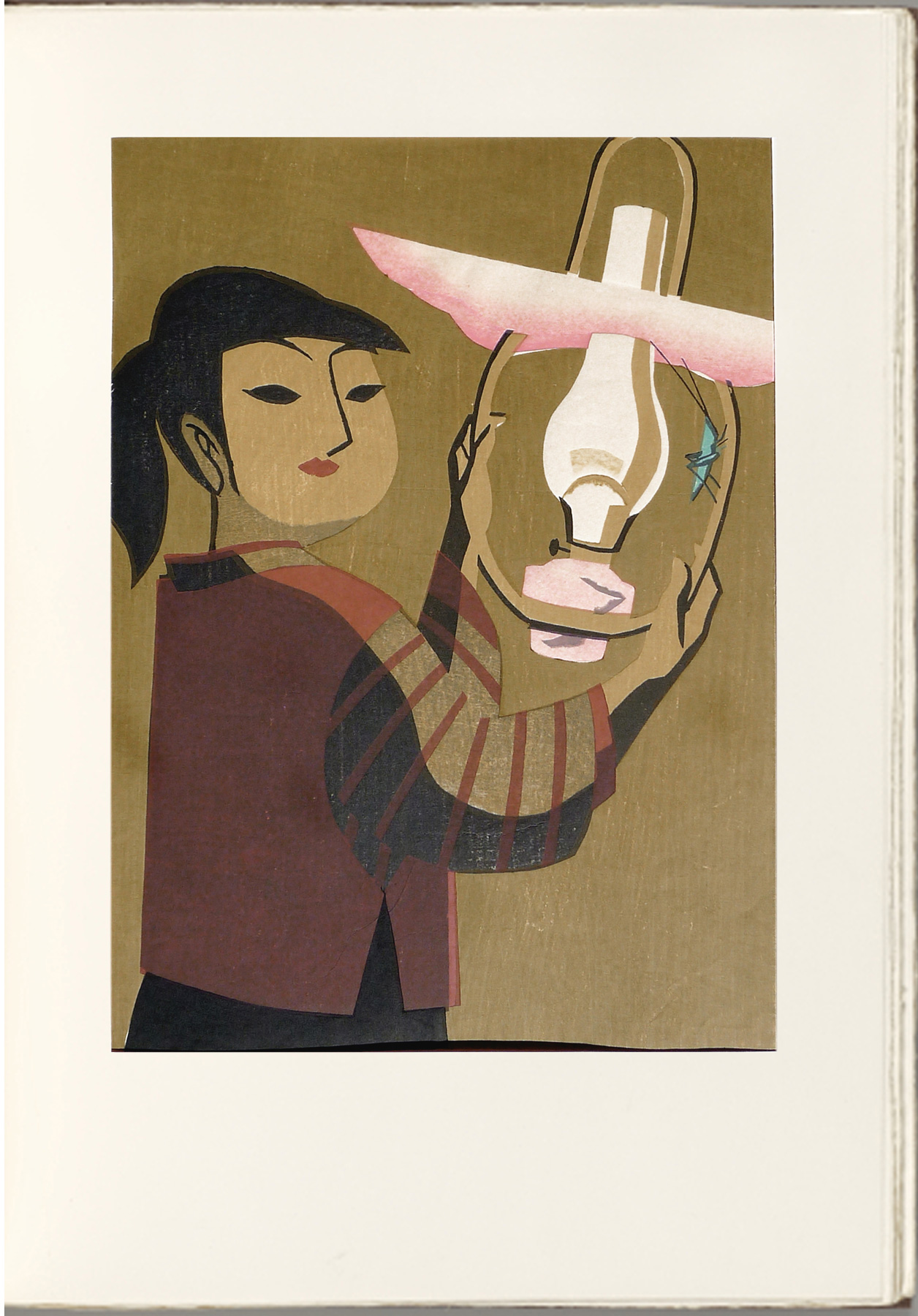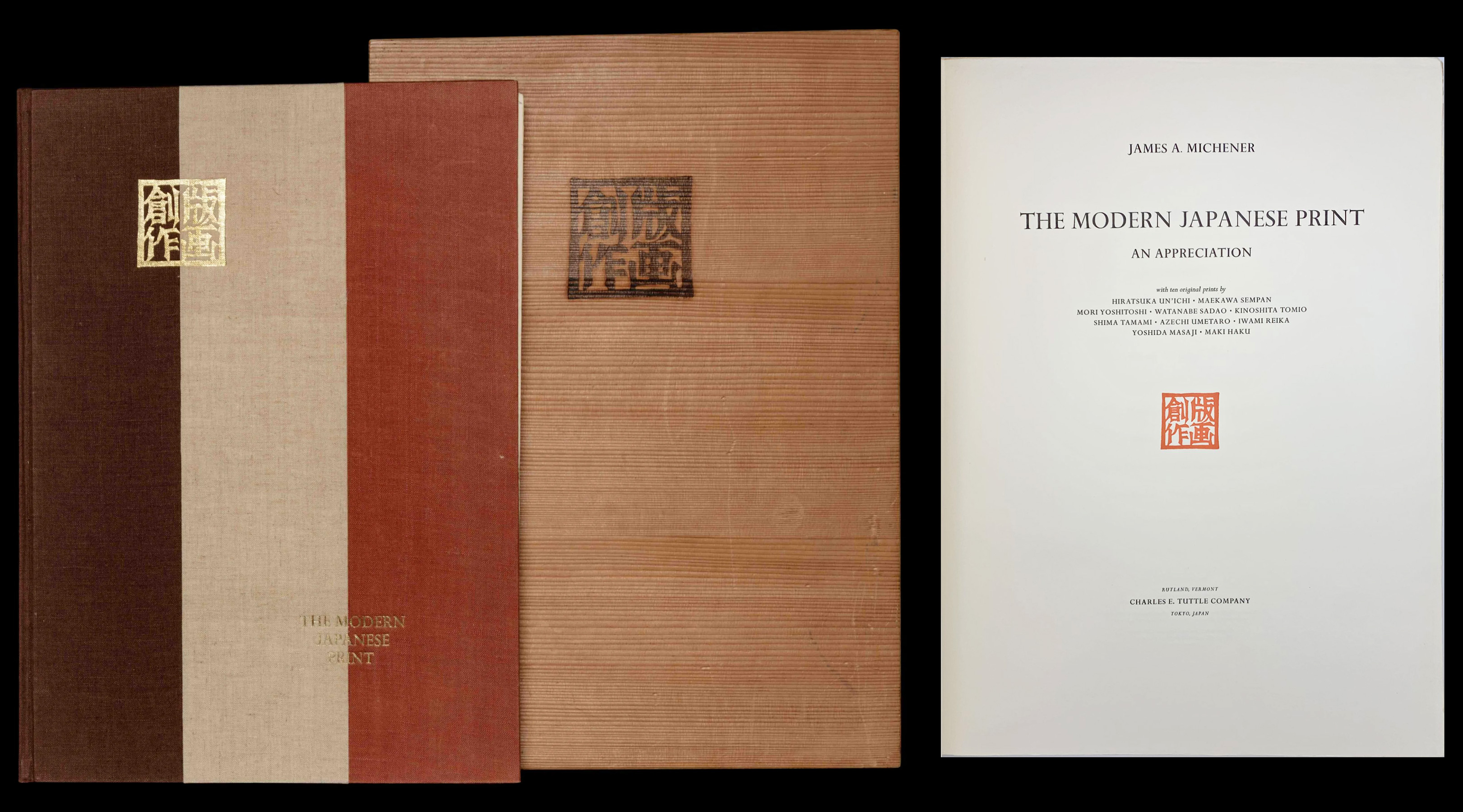About This Print
One of ten modern prints by ten different artists chosen for James Michener’s 1962 seminal work and portfolio of prints The Modern Japanese Print: An Appreciation, a work that brought Iwami and the other artists to international attention.
"The Modern Japanese Print: An Appreciation" by James Michener
Note: Each print is tipped into Michener's book and placed under a mat that covers its margin, hiding the artist's signature, the print's title and the edition number on most of the prints.
IHL Cat. 1336
James A. Michener, The Modern Japanese Print: An Appreciation, 1962
Bound book with ten original prints by Hiratsuka Un'ichi, Maekawa Senpan,
Watanabe Sadao, Kinoshita Tomio, Shima Tamami, Azechi Umemtarō*,
Iwami Reika,Yoshida Masaji, Maki Haku and Mori Yoshitoshi,
housed in a wooden slipcase
(* This collection's book is missing the prints by Azechi Umemtarō and Yoshida Masaji.)
In his introduction to this print, Michener writes in part:
Here Maekawa shows us a country girl holding a lamp at such an angle as to illuminate her very Japanese face. In subject matter the print is thus a pleasant combination of old and new. The face, the lam, and the texture of the cloth are from the permanent past; the pattern of the cloth and the saucy pony-tail hairdo are definitely modern. Thus from the first glance one sees that this print represents a visual compromise.
Of special interest is the fact that the lamp throws upon the face a light which creates a masklike reflection, as if the artist had sought to convey by this subtle means the essential masklike character of the Japanese face with its large plastic forms, flat areas, and contrasting eyes. In no other country that I know have masks been so widely used as in Japan; religion and theater alike have made use of superb masks, and a collection of the historic wooden faces of the past centuries can be impressive.
In fact, the most appealing aspect of this print is its honest use of print techniques, and no work that appears in this book is more wholly within the print tradition than this. It is composed, first of all, of flat areas of color applies in large masses. The girl's hair, her face, her costume, and the right-hand shadow running down the chimney are all large masses used as they should be in print-making. The construction of the right hand is especially interesting, since it demonstrates how solid masses of color can be utilized to create the impression of form.
As for this print, it falls securely within the tradition that Maekawa long ago established for himself. The subdued color scheme is his. The touch of pink has been called almost a Maekawa trademark. And the winsome little girl is a sister to the hundreds of others he depicted. He was an artist with a feminine approach to life, indifferent to the tides of modernism that have swept his colleagues, and content to look lovingly at the village aspects of a land and a society that he obviously loved.1
Autumn is my favorite season, particularly early autumn when the first cool days come around. In this print I fetched from my childhood memories of autumn days one of the lamps that we used to use and then perched an autumn insect on it.2
Artist's title: "Rampu" (Lamp). Six blocks of Judas-tree board and basswood veneer. Printed in eight colors from Japanese pigments and poster colors on torinoko paper. Number of impressions not stated by the artist but presumed to be the same as the number of colors in view of Statler's remark that Maekawa liked to get each of his colors from a single heavy impression.3
1 The Modern Japanese Print - An Appreciation, James Michener, Charles E. Tuttle Co., 1968, p. 20-21.
2 Ibid., p. 22.
3 Ibid.
Print Details
latest revision:
| IHL Catalog | #1336b |
| Title | Lamp (Ranpu ランプ) |
| Artist | Maekawa Senpan (1888-1960) |
| Signature | Senpan Maekawa in pencil, right side of bottom margin hidden by mat |
| Seal | no artist's seal |
| Publication Date | 1962 |
| Edition | 463/510 |
| Publisher | Charles E. Tuttle Company, Tokyo |
| Carver | self-carved |
| Printer | self-printed |
| Impression | excellent |
| Colors | excellent |
| Condition | excellent |
| Genre | sosaku-hanga (creative print) |
| Miscellaneous | |
| Format | dai-ōban |
| H x W Paper | 16 1/4 x 12 3/16 in. (41.3 x 31 cm) |
| H x W Image | 15 1/8 x 11 in. (38.4 x 27.9 cm) |
| Collections This Print | Portland Art Museum, Portland, Oregon 2004.39b; Brooklyn Museum 63.15.2; Philadelphia Museum of Art 1964-201-2(10); Birmingham Museum of Art, Alabama 1990.93.2; The British Museum 1981,0205,0.1.2; Weatherspoon Art Museum, The University of North Carolina 1981.2837.2; Museum of Fine Arts, Boston 63.455; Honolulu Museum of Art 14935 |
| Reference Literature | The Modern Japanese Print: An Appreciation, James A. Michener, [with Ten Original Prints by Hiratsuka Un'Ichi, Maekawa Sempan, Mori Yoshitoshi, Watanabe Sadao, Kinoshita Tomio, Shima Tamami, Azechi Umetaro, Iwami Reika, Yoshida Masaji, Maki Haku], Rutland, Charles E. Tuttle Company, 1962; The Modern Japanese Print - An Appreciation, James Michener, Charles E. Tuttle Co., 1968 [the "popular edition"] |
8/29/2021 created



